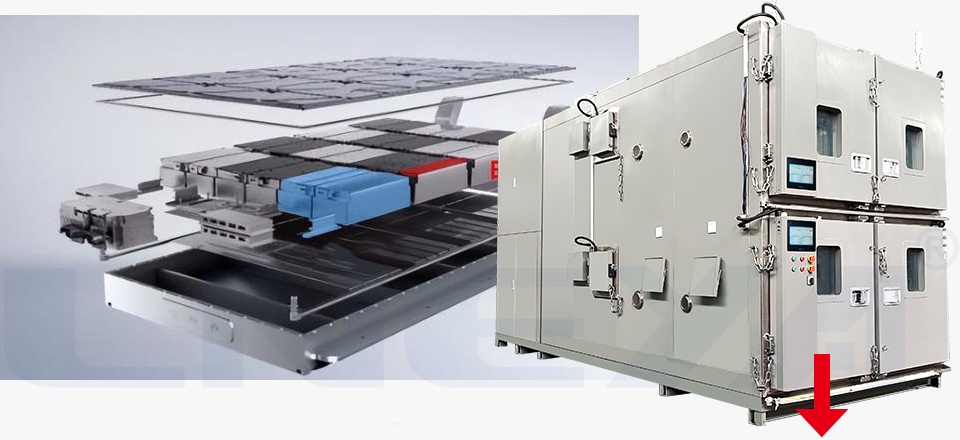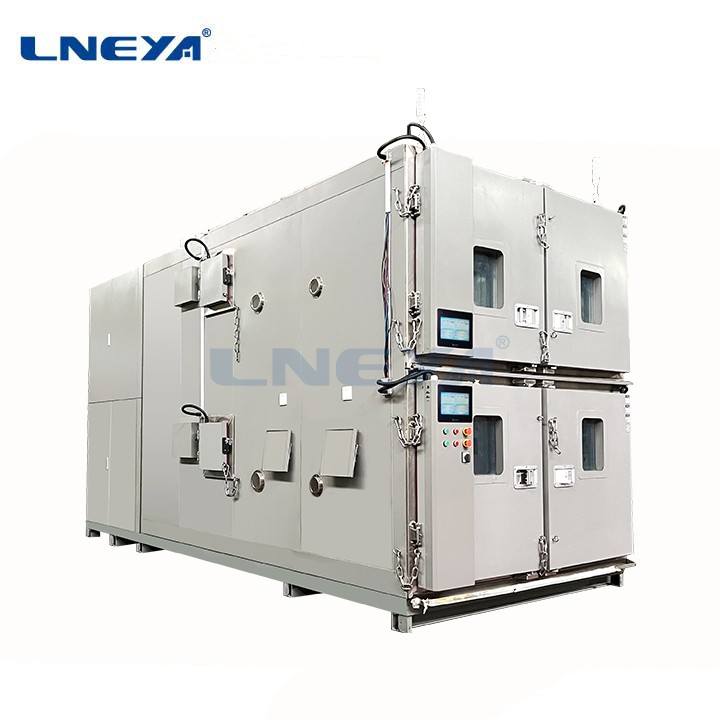Perché le batterie necessitano di test di congelamento?
道路上で増加している電気自動車の数に気付きましたか?
新しいエネルギー技術の発展と環境意識の向上により、バッテリー駆動の車両は今や日常生活の中で一般的な光景となっています。冬に電気自動車がなぜもっと遅く充電され、速く放電されるのか疑問に思ったことはありますか?これはバッテリーの寿命に影響を与えますか?なぜ一部の電気自動車は-20℃の環境でも安定したパフォーマンスを発揮するのでしょうか?
これは研究開発の重要なステップである「バッテリー低温テスト」と密接に関連しています。バッテリー低温テストとは何ですか?なぜこれを行うのでしょうか?バッテリーが凍るとどうなるのでしょうか?凍結テストはどのように行われるのでしょうか?この記事は、バッテリーテストの謎を解明します。
なぜバッテリーを凍らせるのですか?
バッテリーの凍結テストは、実際の使用で遭遇する可能性のある低温環境をシミュレートすることを目的としています。北米、北ヨーロッパ、ロシアなどでは冬の気温が非常に低く、電気自動車の始動が困難になることがあります。コールドチェーン輸送設備や一部の極地探査設備では、低温によりバッテリーシステムが故障したり、ショートしたりする可能性があります。
使用中にこれらの問題が発生しないように、研究開発担当者は低温での性能を事前に理解する必要があります。材料の耐寒性、バッテリーの寿命、内部化学反応、低温の臨界値を評価する必要があります。

バッテリーが凍ると何が起こりますか?
低温環境でバッテリーはどのように動作しますか?主な効果は以下の通りです:
遅い充電
冬に電気自動車を充電する際、完全に充電するまで時間がかかるのは、低温がバッテリーの充電速度に影響を与えるためです。低温では、電解液の粘度が増し、電解液内でリチウムイオンの移動抵抗が増加し、バッテリーの充電効率が低下します。低温環境で充電を続けると、リチウム金属の沈着が発生し、それがバッテリーを損傷させ、最終的には熱暴走を引き起こす可能性があります。
加速された放電
冬に電気自動車を短距離運転した後、バッテリーの電力が大幅に減少することに気づいたかもしれません。バッテリーが電力を供給できる理由は、内部で化学反応が起こり、化学エネルギーが電気エネルギーに変換されるためです。バッテリーが外部回路に接続されると、リチウムイオンは負極から移動し、外部回路を通じて正極に到達し、電流が形成されます。低温ではリチウムイオンの移動が妨げられ、バッテリーの内部抵抗が増加し、放電時の電圧が低くなり、使用可能な電力が減少します。
安全上の危険
極端に低い温度では、電解液が結晶化したり、リチウムが部分的に沈殿したり、膨張、漏れ、短絡などの構造的損傷が発生する可能性があります。走行中の車でこれらの問題に遭遇すると、運転手や乗客の生命安全に大きな危険をもたらします。
異なる低温でのバッテリーの性能
バッテリーは異なる低温範囲で異なる性能を発揮します。さまざまな温度帯でのテストは、研究開発担当者がバッテリーの公式を最適化し、バッテリーセルのパッケージングの安定性を評価するのに役立ちます。
| 温度範囲 | バッテリーの性能 |
| 0℃ ~ -10℃ | わずかな性能低下、まだ動作可能 |
| -10℃ ~ -20℃ | 顕著な容量の損失、起動電圧の不足、短くなった放電時間 |
| -20℃ ~ -40℃ | ほとんどのリチウムバッテリーは正常に機能しません。特別な低温用バッテリーが必要です。 |
| -40℃ ~ -80℃ | 航空宇宙、軍事およびその他の過酷な環境での極限テスト範囲 |
バッテリー凍結テストの基準
バッテリーの信頼性を確認し、比較および認証を容易にするために、多くの国や地域でバッテリー凍結テストの基準が発行されています。
IEC 62660
国際電気標準会議(IEC)は2010年にIEC 62660規格を発行しました。この規格は、電気自動車の電力システムに使用されるすべてのリチウムイオンセルに適用されます。バッテリー容量テスト、電圧保持テスト、サイクル寿命テストは-20°Cで実施することが規定されています。テスト環境、テスト方法、バッテリーの資格基準も規定されています。
UN 38.3
国連経済委員会は1999年にUN 38.3規格を発行し、この規格は継続的に更新されています。これは、電気自動車、携帯電話、電動工具など、国際輸送に使用されるすべてのリチウムバッテリーおよび完成したバッテリーパックに適用されます。バッテリーは-40°C±2°Cで6時間保管され、その後+75°C±2°Cでさらに6時間保管され、5日間でこのサイクルを10回繰り返す必要があります。テスト中にバッテリーが漏れ、膨張、火災、爆発しないこと、そして定格電圧要件を満たしていることが合格の要件となります。
SAE J2929
自動車技術者協会(SAE)は2008年にSAE J2929を発表し、2020年に改訂しました。この標準は、米国で販売される電気自動車およびハイブリッド車のバッテリーシステムに適用されます。バッテリーシステム全体の環境シミュレーションを要求しており、低温での運転、低温での充電、低温での故障モードを含みます。テスト温度は、北米の冬季温度をシミュレートするために-30°Cに制御することが推奨されています。
NASA-STD-4009
アメリカ航空宇宙局(NASA)は2021年にNASA-STD-4009を改訂しました。この標準は、宇宙船、衛星、および深宇宙探査機器のバッテリーシステムに適用されます。バッテリーシステムの気密性、熱制御能力、および電気化学的安定性を極低温で評価するために、-60°Cまたはそれ以下でのテストが必要です。
GB/T 31467
中国の市場監督管理総局は2015年にGB/T 31467を発行しました。この規格は、電気自動車用のリチウムイオン蓄電システムに適用されます。バッテリーは-20°Cで容量、出力、充放電性能テストを受ける必要があり、テスト方法と温度制御ボックスの誤差(±2°C)が指定されています。
| 標準名 | 国/組織 | 温度要件 | Main Application | Release Year |
| IEC 62660 | International / IEC | -20℃ | Performance and safety testing of EV single cells | Since 2010 |
| UN 38.3 | United Nations / UNECE | -40℃ cycling | Transportation adaptability and safety testing of batteries | Since 1999 |
| GB/T 31467 | 中国 | -20℃ | Performance and safety testing of EV battery packs | Since 2015 |
| SAE J2929 | USA / SAE | -30℃ | Safety and performance of battery pack systems | Since 2008 |
| NASA-STD-4009 | USA / NASA | -60℃ and below | Special battery testing for aerospace applications | 2021 Edition |
How is the battery freezing test conducted?
The following are the basic procedures and precautions for battery freezing testing.
Prepare samples
It is necessary to select representative cells and battery packs, and inspect the samples carefully to ensure that they are free from obvious defects, such as bulging and leakage.
Record the initial state
For the convenience of comparison, record the initial voltage, resistance, state of charge and other data of the battery. If you want to perform a cycle test, you also need to record the data of the last test.
Set a low temperature environment
According to the corresponding test standards, set the target temperature on the touch screen of the battery test box, which is generally -20 and -40℃. If it is a battery used for aviation, it needs to be set to about -70℃. To avoid thermal shock, you need to set a reasonable cooling rate.
Slow cooling
Place the battery in the test box and close the door, ensuring even thermal conduction through the sample holder. Wait for the temperature in the environmental test box to drop to the target temperature. Avoid frequent opening and closing of the box door during this process.
Maintain constant temperature
After reaching the target temperature, the sample needs to be placed in a constant temperature environment for at least 6 hours according to the requirements of the standard. During this period, the temperature fluctuation curve needs to be recorded to keep the temperature uniformity within ±2℃.
Testing
Perform discharge test, charge test and cycle test under low temperature conditions. Record battery capacity, voltage, internal resistance, discharge rate and other data. Compare with parameters at room temperature.
暖房
After the test, slowly warm the battery to room temperature. It should be noted that the battery do not expose it directly to ambient room temperature, which will cause condensation or thermal stress damage. Then perform a safety check on the battery to check for bulging, leakage and other problems.
Note
• Make sure that the sample battery has no obvious damage
• Do not charge at extremely low temperatures
• Before discharging, it is necessary to maintain a constant temperature for a long enough time to avoid uneven cooling of the battery cell
• Someone must be present during the test
Performance of different types of batteries in freezing tests
Different types of batteries have different performance and behave differently in low temperature environments.
| Battery Type | Low-Temperature Characteristics |
| Ternary Lithium Battery | High energy density but poor low-temp performance; fast capacity fade; suitable for temperate climates |
| Lithium Iron Phosphate (LFP) Battery | High safety, better low-temp performance; can discharge at -20℃, but has lower energy density |
| Solid-State Battery | New battery technology with good low-temp stability; commercialization is still in progress |
| Nickel-Metal Hydride (NiMH) Battery | Significant capacity loss at low temperatures; suitable for low-power devices |
| Sodium-Ion Battery | Under development; early data shows better low-temp performance than traditional lithium batteries |
How to choose a battery test chamber?
If you buy a battery chamber for the purpose of testing electric vehicle batteries, how should you choose? You need to consider the following factors:
| Item | 説明 |
| 温度範囲 | Recommended: -70℃ to +100℃ (covers extreme environments) |
| 温度制御精度 | At least ±0.5℃ (depending on testing standard) |
| Temperature Uniformity | ≤±2℃ to ensure consistent data for multiple battery samples |
| Cooling Rate | Recommended ≥1℃/min; some standards require ≥5℃/min |
| Data Logging | Should automatically record temperature, voltage, time, and other test data |
| Compatibility | Supports battery testers, communication interfaces, gas monitoring modules, etc. |
| Safety System | Equipped with over-temp alarm, power failure protection, leakage detection, etc. |
| After-sales & Customization | Supports customization, fast delivery, and technical consultation |
結論
Battery testing is necessary to ensure the safety of equipment and personnel. Generally, specially designed battery test chambers are used to simulate real-world application environments to test the performance of batteries at different temperatures. If you are looking for a reliable battery test chamber manufacturer, LNEYA is happy to provide you with customized solutions and technical support.
今日、LNEYAに連絡して、あなたの特定のニーズに合わせたカスタマイズされたバッテリーテストチャンバーの全範囲を探索してください。
関連冷凍機
お問い合わせ
TEL
EMAIL:
WeChat & WhatsApp:ウィーチャット

ウィーチャットQR

ご質問やお見積りをご希望の場合は、以下のフォームにご記入ください。24時間以内に担当者よりご連絡させていただきます。
 LNEYA工業用冷凍機 メーカー サプライヤー
LNEYA工業用冷凍機 メーカー サプライヤー














